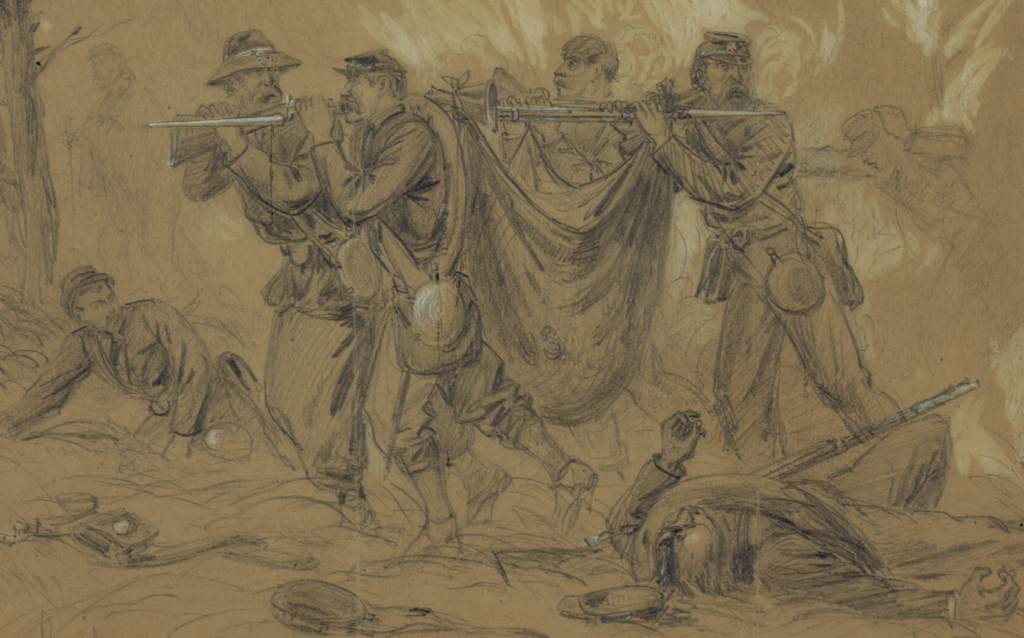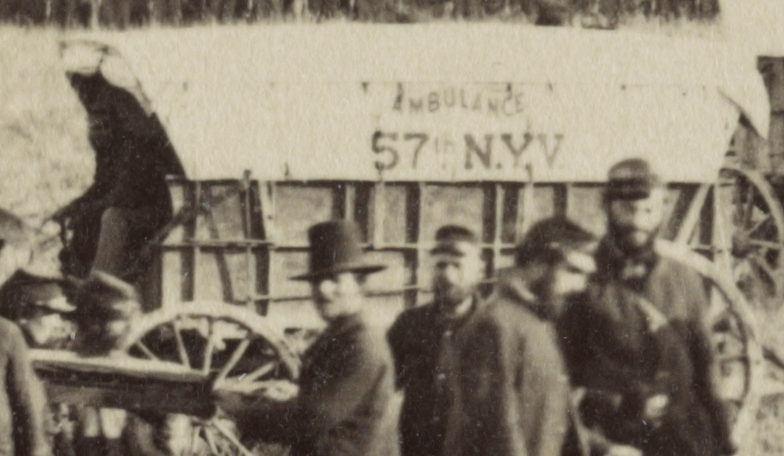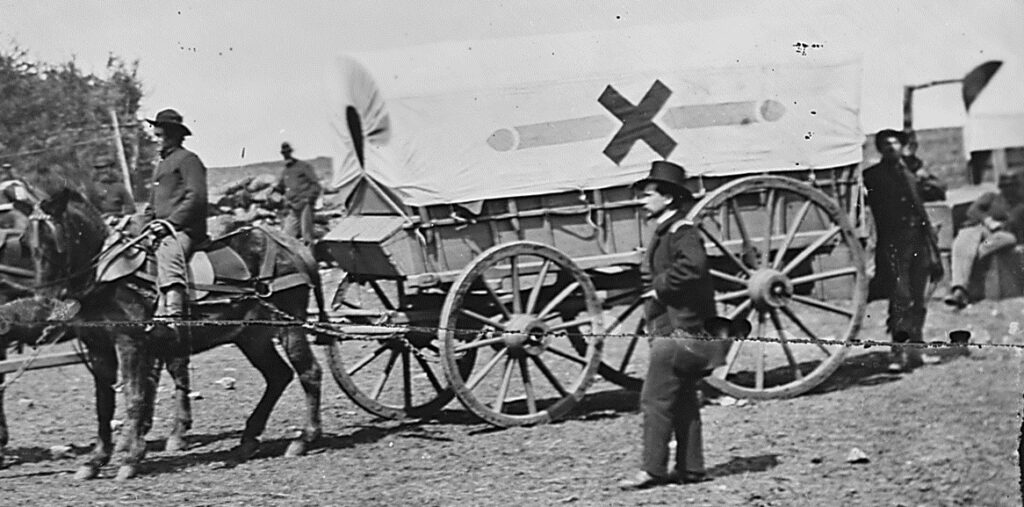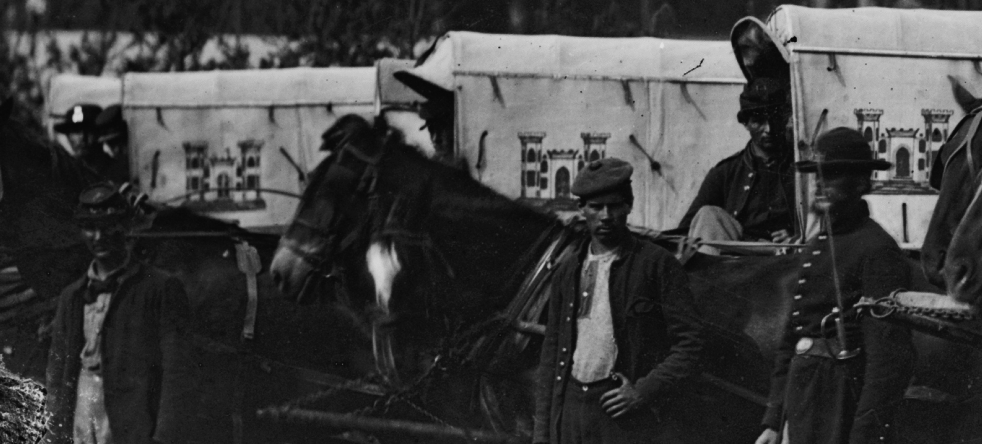“They Did Not Seem to Respect It Much”: Insignia and Medical Evacuation
Originally published in 2020 in the Surgeon’s Call, Volume 25, No.1
Museum members support scholarship like this.
The Civil War created a massive humanitarian crisis by the sheer scale of wounding and death. Mass casualty events were distressingly common throughout the conflict. These previously unimaginable catastrophes required adaptation both on the ground and in military medical administration to treat the wounded. Among the most important of these challenges was removing the wounded in a timely and safe manner from active battlegrounds.

Figure 1: Unknown Ambulance Corps soldier. NMCWM collection (L3.2000.004)

Figure 2: Private Bruce Shipman, 76th New York, Co. K. Courtesy of the U.S Army Heritage and Education Center
The uniform for this corps is: For privates, a green band 2 inches broad around the cap, a green half chevron 2 inches broad on each arm above the elbow, and to be armed with revolvers; non-commissioned officers to wear the same band around the cap as a private, chevrons 2 inches broad and green, with the point toward the shoulder, on each arm above the elbow.[i]
Two years later, using Letterman’s system as a guide, General George Thomas ordered his Army of the Cumberland to wear green bands around their caps and arms.[ii] Photographic evidence bears out the use of the green stripe and chevron by soldiers of the ambulance corps. In the collection of the National Museum of Civil War Medicine is a remarkably rare example of this uniform in an original portrait of an unidentified Ambulance Corps soldier. A similar portrait of Private Bruce Shipman of the 76th New York Infantry is in the U.S. Army Heritage and Education Center collection.
Figure 3: Unidentified Ambulance Corps sergeant. Sold on eBay, presumably in private collection

Figure 4: Detail with potential ambulance corps corporal from “Winter Quarters, troops with row of cabins,” Brady album, p. 128, 1861–65. Courtesy of the Metropolitan Museum of Art

Figure 5A and 5B: Details from “Falmouth, Va. Men and wagons of the Engineer Corps ambulance train,” Timothy H. O’Sullivan. Courtesy of the Library of Congress

Figure 5A and 5B: Details from “Falmouth, Va. Men and wagons of the Engineer Corps ambulance train,” Timothy H. O’Sullivan. Courtesy of the Library of Congress

Figure 6: Ambulance Corps Badge. NMCWM collection (L 2012.016.009)

Figure 7: Detail of Union ambulance corps soldiers from “The Rebel Dodge to Cover the Retreat into Virginia. Flag of Truce to Look After the Wounded,” Alfred R. Waud, September 1862. Courtesy of the Library of Congress

Figure 8: Detail of Confederate ambulance corps soldiers from “The Rebel Dodge to Cover the Retreat into Virginia. Flag of Truce to Look After the Wounded,” Alfred R. Waud, September 1862. Courtesy of the Library of Congress

Figure 9: Detail from “Virginia, City Point. Park of Army Wagons,” published July 1863. Courtesy of the Library of Congress

Figure 10: Detail from “Wounded Escaping from the Burning Woods of the Wilderness,” Alfred R. Waud, May 5-7, 1864. Courtesy of the Library of Congress

Figure 11: Detail from “Unknown location. Zouave ambulance crew demonstrating removal of wounded soldiers from the field; another view.” Courtesy of the Library of Congress

Figure 12: Detail from “Removing wounded, Fredericksburg, Va. 57th N.Y. Ambulance Corps.” Courtesy of the Library of Congress

Figure 13: Detail from “Ambulance of the 6th Corps,” Matthew Brady. Courtesy of the National Archives and Records Administration

Figure 14: Detail from “Falmouth, Va. Men and wagons of the Engineer Corps ambulance train; another view,” Timothy H. O’Sullivan, November 1862-April 1863. Courtesy of the Library of Congress

Figure 15: Detail of V Corps ambulance in “Massaponax Church, Va. Council of War Gen. Ulysses S. Grant examining map held by Gen. George G. Meade,” Timothy O’Sullivan, May 21, 1864. Courtesy of the Library of Congress

Figure 16: Ambulance Flag. Courtesy of the National Park Service, Gettysburg National Military Park
Want to learn more? Follow us on Facebook and Twitter to discover more stories from Civil War medicine!
Become a museum member and support our educational programs and research like this.
